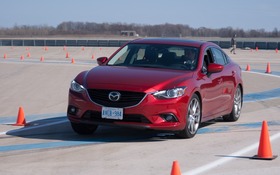Mazda i-Activsense, a technology that can prevent accidents - and save lives
Mazda revamped the Mazda6 for 2014, improving efficiency and reducing fuel consumption by applying Skyactiv technology to the body and drivetrain. The company has also improved safety by applying i-Activsense safety technologies in a package that can include up to eight different driver aids.
There’s no better way to test new safety features than getting behind the wheel and using them, so Mazda presented a demonstration at the ICAR circuit in Mirabel, Quebec, where I sampled firsthand several of these new driver aids.
- Also: 2014 Mazda6: Humans Are Capable Of Building Beatiful Things
- Also: 2014 Mazda MAZDA6: Dress For The Job You Want, Not The One You Have
At the base of the new i-Activsense system is a series of cameras, lasers and radar that monitor the driving environment and feed the information to a computer that, if necessary, gives commands to various control systems, intervening and either warning the driver or taking control if it is determined that a collision is imminent.
Smart City Brake Support
The first system tested was the Smart City Brake Support (SCBS). This system operates at speeds between 4 and 30 km/h and uses a forward-pointing laser to detect a car up to 6 metres ahead. When it initially senses a collision is possible, it will first preload the brakes, which will reduce the reaction time as soon as you push on the brake pedal. If it determines that there is a risk of a collision with the car ahead, it will slow you down and if you don’t take any further action, it will apply the brakes and stop the car.
I tested the system by driving towards an immovable object at 20 km/h, and after overcoming the urge to hit the brakes as I approached the obstacle, I let the Mazda6 do its thing, which it did and promptly stopped with about one metre to spare. I was told that as you approach 30 km/h, the upper threshold speed at which the system operates, there is a greater chance that you will collide with the vehicle ahead, though the SCBS will greatly reduce the impact. Unfortunately, it is not designed to detect smaller objects like motorcycles or pedestrians. SCBS is only available with the automatic transmission.
Forward Obstruction Warning
At higher speeds, forward-facing radar detects if there is a vehicle ahead, and if you approach it too quickly, the Forward Obstruction Warning (FOW) system will flash a “BRAKE” signal in the dashboard to call your attention ahead. Radar is also used in the adaptive cruise control system, helping maintain a preset distance between the vehicle ahead, adjustable from 25 to 50 metres in four increments.
I sampled the system on a nearby highway and put my faith in it completely, when I followed a colleague in a Mazda6 ahead onto an exit ramp without touching the brakes. The car slowed from 100 km/h to almost a stop before I hit the brakes. I was not brave enough to leave my foot off the brake pedal for the entire distance, but theoretically, once the speed drops below 30 km/h, SCBS should take over and stop the car completely. Since I was told that at speeds nearing 30 km/h there was a possibility of a collision, albeit a small one, I braked to a stop, saving myself the trouble of having to explain to my editor why I crashed into another test car.
Lane Departure Warning System
The Lane Departure Warning System (LDWS) uses a forward-facing camera to identify lines in the road and give an audible warning, through the sound system speakers, if you are drifting out of your lane. The system is very effective—if the lines in the road are clearly visible. Unfortunately, in Quebec, it is more common that the painted lines are worn, faded or completely absent, so the LDWS is not as effective here as it should otherwise be. The warning tone is programmed to mimic the sound of driving over the rumble strips often located at the shoulder of the road. The warning sound is directional, coming from the right speakers when drifting right and the left speakers when drifting left. The low frequency sound is loud and makes the doors vibrate; it is as startling as when you hit actual rumble strips.
High Beam Control
Other convenient systems include the High-Beam Control (HBC), which automatically switches the headlights from high beams to low beams at night when a vehicle approaches from the other direction, and turns the high beams on again after the vehicle has gone past. It also turns off the high beams automatically at speeds below 30 km/h or on well-lit roads. The Adaptive Front-lighting System (AFS) is used in the headlights, aiming the light beam into the direction of a turn.
Blind Sport Monitoring and Rear Cross Traffic Alert
Other driver aids include Blind Spot Monitoring (BSM) and Rear Cross Traffic Alert (RCTA); the first system warns you if a vehicle is in your blind spot, the second warns you if a vehicle is approaching from either side when you’re backing up. Both systems use audio and visual cues to give warning.
Various i-Activsense systems are available on the Mazda6 GS an GT models. Blind Spot Monitoring and Rear Cross Traffic Alert are available in the GS (starting at $28,395), the GT ($32,195) adds the Adaptive Front-lighting System, and the GT with automatic transmission and the Technology Package ($34,195) includes all of the i-Activsense safety systems.
Most of these systems are available in one form or another from other manufacturers, but Mazda is the only company to offer the possibility of including all of the systems on a single model.












